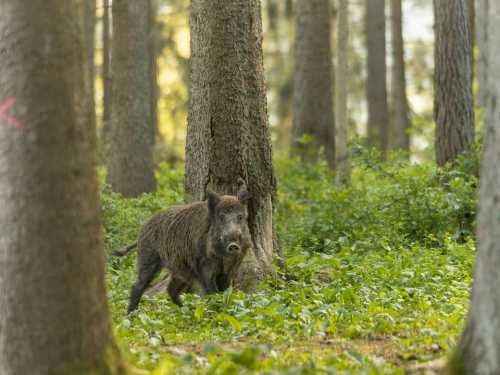
To an uninitiated person, it may seem that this animal is quite ordinary. Well, a wild boar! Well, it chews acorns! Well, it runs through the forest! What could be unusual here? Someone else might recall the similarity with domestic pigs. Do you think everything is so simple? But it is not! The ancestors of domesticated pigs hide a lot of secrets.
Distant relative
The physiology and genetics of wild boars (and domestic pigs) are strikingly similar to humans—we share about 98% of our DNA, making us as closely related to pigs as we are to chimpanzees. This makes them one of the most valuable biomedical models. Their organs, such as the heart, kidneys, and skin, are very similar in size and function to those of humans. This has provided the basis for a wide range of research, from the development of new drugs and surgical techniques to the promising technologies of xenotransplantation—the transplantation of organs from animals to humans.
Researchers are actively working on genetically modifying pigs to minimize the risk of organ rejection after transplants. For example, scientists are modifying the genes of pigs so that their organs do not contain viruses that can be transmitted to humans and are more compatible with the immune system. This opens the door to the potential replacement of damaged human organs with pig organs, a real breakthrough in medicine.
Exceptional sense of smell
Wild boars have one of the most acute senses of smell in the animal kingdom, which is key to their survival. This incredible ability develops before birth – studies have shown intense neural activity in the fetal olfactory mucosa and early genetic programming of olfactory receptors. Over 1,301 olfactory receptor genes have been found in the pig genome, which explains their ability to perceive a wide range of odors.
They are able to detect food hidden underground from considerable distances—roots and tubers, as well as mushrooms such as truffles, have been known to be found up to a meter deep. But that’s not the limit: wild boars can detect smells up to 10 miles away, and with a favorable wind, even further. Even more impressive is their ability to detect smells underground at depths of up to 25 feet.
The wild boar's sense of smell is so perfect that they are even used to detect drugs in Germany. Compared to humans, pigs have more olfactory receptors and can detect odors at concentrations many times lower than we can, as well as perceive some odors that humans cannot detect at all.
Real gourmets
Contrary to popular belief, wild boars have well-developed taste buds and can distinguish between bitter, sweet, sour, salty, and umami tastes. In fact, they prefer sweet and protein foods, which stimulates their intensive feeding.
Wild boars are often used to find truffles because their sense of smell, combined with their burrowing instinct, is extremely effective. The secret is that truffles emit pheromones similar to those found in the saliva of male wild boars, making them incredibly attractive to females. However, training a wild boar to find truffles is difficult as they are likely to eat the find, so dogs are often preferred.
Master of Strategy and Adaptation
Wild boars are creatures of habit, especially when they find places with abundant food and safety. They create an extensive network of trails that they use regularly, returning to their favorite resting places until the resources in that area are depleted. This behavior is an effective strategy to conserve energy and minimize risks in their environment.
People have long noticed this trait and used it in hunting. For example, historical records indicate that to catch wild boars, hunters dug deep pit traps along their regular routes, which significantly increased the effectiveness of hunting. Interestingly, in the Middle Ages, pig owners used horns tuned to different tones to call their animals – pigs could recognize their owner's unique sound among others.
Using well-trodden paths not only optimizes their movement, but also plays an important role in the ecosystem. Wild boars, by following the same paths, spread plant seeds, and their digging of the ground contributes to soil aeration and the spread of fungi, which is important for forest biodiversity. The size of their home range can vary greatly from a few square kilometers to dozens, depending on the availability of food, water and shelter.
Underrated intelligence and amazing hygiene
Wild boars are highly intelligent and have the ability to think adaptively, making them extremely cunning and resourceful. Studies have shown that pigs (both domestic and wild) have excellent long-term memories and can solve complex tasks, such as navigating mazes. Their cognitive abilities are often compared to those of dogs and even some primates.
In direct comparison tests, pigs often outperform dogs. When dogs and miniature pigs were given complex tasks to solve, the pigs worked hard to solve the problem on their own, while the dogs sought help from humans. In terms of cognitive development, pigs are on par with a three-year-old child, while dogs are on par with a two-year-old.
The intelligence of wild boars is also evident in their social structure and ability to communicate within a group. Research has identified four main types of vocalizations in wild boars: grunts, grunt-squeaks, squeals, and trumpets. Each type has its own function in their complex communication system.
In 2021, scientists recorded a unique case of rescue behavior: an adult female wild boar freed two young boars from a trap by manipulating wooden blocks of a door mechanism. The operation was quick and precisely directed, indicating profound prosocial abilities and exceptional problem-solving skills.
They are known for their ability to avoid traps, remember dangerous places, and even learn from experience to outwit predators or hunters. Wild boars can exhibit complex behaviors, hiding in the thicket to make an unexpected maneuver, or using the environment to their advantage.
One of the key aspects of their lives is their frequent wallowing in mud, which is not just for fun. It is an important behavior that helps them regulate their body temperature, as wild boars lack sweat glands and overheat in the sun. In addition, the mud acts as a natural defense against insect parasites such as ticks and mosquitoes, and it also helps heal minor scratches and wounds by protecting the skin.
Omnivorous invader and ecological engineer
The wild boar is a true omnivore, which allows it to survive in a wide range of environments. Its diet includes roots, tubers, mushrooms, acorns, fruits, insects, small rodents, bird eggs, snakes and even carrion. As opportunistic omnivores, they typically consume between 3% and 5% of their total body weight each day, adapting their diet to seasonal food availability. This explains their incredibly wide range, which covers much of Eurasia and North Africa.
However, their omnivorous nature and rapid reproduction also make them a formidable invasive species in regions where they have been introduced, particularly in North and South America, as well as Australia. There, they are known as “feral pigs” and can cause significant damage to agriculture and local ecosystems.
Wild boar populations can double every four months due to their early sexual maturity (females can breed as early as 6 months) and ability to increase their numbers by 150% annually. Females produce two litters of 4-6 piglets every 12-15 months, making them extremely successful colonizers.
In Australia, feral pigs cause over $100 million in economic damage annually and destroy up to 70% of sea turtle nests in northern Queensland. In the US, annual costs from damage and control are estimated at $2.5 billion. Studies show a 26% reduction in vertebrate diversity in forest fragments they occupy.
In Canada, feral pigs have developed unique adaptations to the cold climate, including building “pigles” – dome-shaped shelters made of snow and vegetation for wintering, demonstrating their incredible adaptability.
Social hermit
The social structure of wild boars is clearly divided by sex and age. Females, or sows, live in groups called “herds” with their young and adolescents. These groups are led by the most experienced and oldest sow, who provides protection and training for the young.
In contrast, adult males, or sikats, lead a largely solitary lifestyle. They leave their maternal group as soon as they reach sexual maturity and spend most of the year on their own, searching for food and resting alone. Only during the breeding season, usually the autumn-winter season, do males join herds of females to find a mate. After mating, they return to their solitary existence, not taking part in raising their offspring.
During the breeding season, males engage in fierce fights for the right to mate with females. Dominant males often have extensive scars and marks on their skin, especially on their shoulders, where they develop a so-called “shield” – a thickened layer of skin that protects them during fights. This “lone wolf” strategy allows males to avoid competition for resources with females and young during non-breeding periods.
Prospects for coexistence
Wild boars remain one of the most interesting and controversial animals on our planet. Their high intelligence, adaptability and complex social behavior make them fascinating subjects to study. At the same time, their ability to reproduce and adapt rapidly poses serious challenges to the ecosystems they inhabit.
Observing the behavior of wild boars, man was able to adapt them and adapt them to his own life principles. And if ancient man knew even half of what you have understood today, then perhaps we would have evolved much faster!





